Palden Lhamo, the Terrifying Female Protector aspect of Tara: “Sole Mother, Lady Victorious Over the Three Worlds”
As a child, who did you go to for protection — the parent who let you do anything and smiled while you did it, or the parent who yanked you back from the brink with a stern voice and scowl?
Palden Lhamo video documentary (with tea offering!)
Don’t miss the new Palden Lhamo documentary from Buddha Weekly:
“It is this ignorance and stupidity that … wrathful deities are directed against,” explains Rob Preece, a Psychologist. [1] No nonsense, no bull-oney — that’s Palden Lhamo. In Her primary function as a Dharma protector, she protects us — from ourselves. In Tibetan Buddhism, Dharma Protectors serve an important function in cutting ignorance, anger, obstacles, and even dangerous situations.

Palden Lhamo — Nothing Can Stand Against Her
Palden Lhamo, also known as Shridevi, the dark emanation of Vajra Sarasvati (an emanation of Tara, and ultimately Prajnaparamita) — in her fierce form, she is like the no-nonsense stern mother, who so terrifies the neighborhood that none of the bullies dare to bother you. You shout, “Here comes Palden Lhamo” and all the little demon bullies go running.
She is the mother who can lift a car off of a trapped child — the awesome power of a furious mother. You could think of Tara as the “nice mother” supportive and protective, with embracing arms, and Palden Lhamo as the same mother, but super wrathful, enraged, and awesome in Her power; nothing, absolutely nothing, can stand against Her. You can also think of Palden Lhamo as the fierce aspect of wisdom, as the wrathful emanation of Vajra Sarasvati.
JHO! Your mind knows everything in essence and in detail;
You never leave the sphere of emptiness, but out of compassion
You tame enemies and obstacles, every method at your command.
I praise you, conquering female with a glorious body, speech and mind!— from the Tea Offering to Palden Lhamo
- A small tea ceremony to Palden Lhamo at the end of this feature, suitable to honor the Glorious Goddess without empowerment. (Just a praise and prayer.)
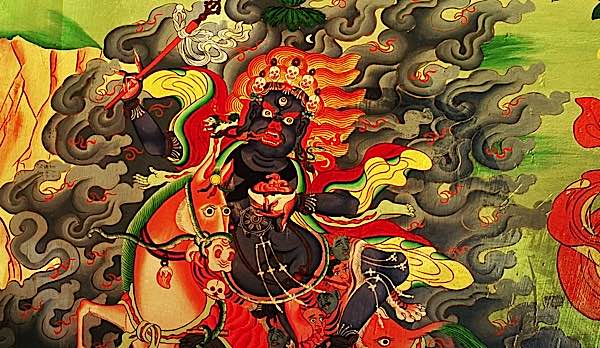
Palden Lhamo: ferocious, but mother

Palden Lhamo, the ferocious yet motherly Buddhist protector, brings to mind the character Ripley (Sigourney Weaver), decked out in a robotic loader in the movie Aliens, confronting the massive acid-drooling demon-alien and snarling: “Let go of her!” Bam — angry, protective mother Ripley drives away the terrible demon.
In a separate feature on Buddhist wrathful deities, we used Arnold Schwarzenegger as the wrathful icon. We asked, if you were attacked by a violent gang, who would you rather have at your side, tough-guy Arnie or a man dressed neatly in a pin-striped suit. Except here, Palden Lhamo’s protective ferocity is magnified by Her motherly bond. Like Ripley, nothing can stand between Her and Her child.
IMPORTANT NOTE: You usually do NOT visualize yourself as Palden Lhamo. Her practice is almost always a front-generation practice (visualizing her in front of you) with yourself visualized as your own Yidam — or Yamantaka in most Sadhanas. Unless your teacher guides you differently, do NOT self-generate as Palden Lhamo.

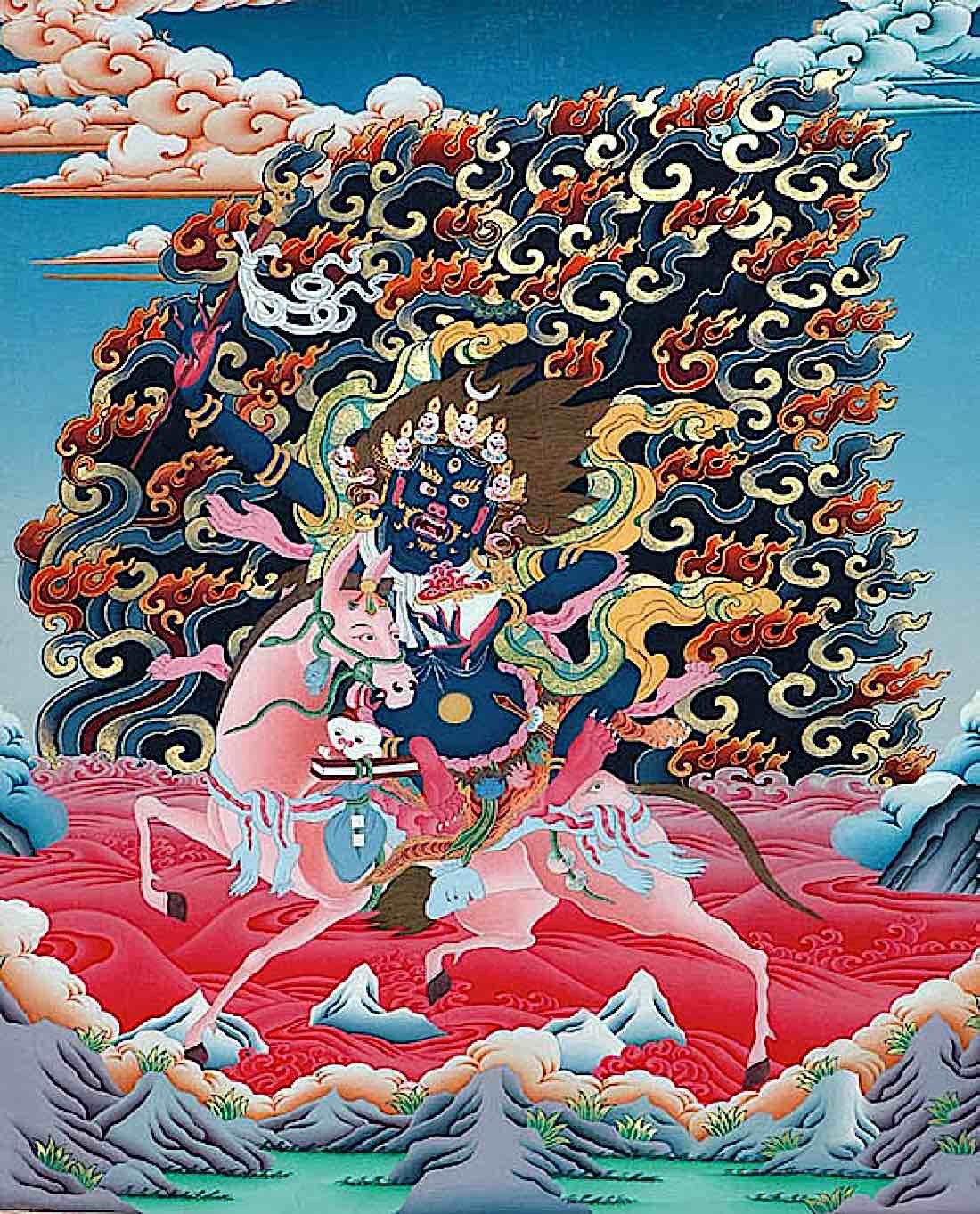 This is symbolically reinforced by Her Ghoulish appearance, horrifying enough to send even the most terrifying demon yelping for cover. “She is almost naked, and her body is wreathed in snakes and adorned with bone ornaments and a necklace of skulls. In her left hand, she bears a brimming skull cup. In her right hand, she holds aloft a black skull-topped staff… Flames roar and black storm clouds swirl around her…” [3]
This is symbolically reinforced by Her Ghoulish appearance, horrifying enough to send even the most terrifying demon yelping for cover. “She is almost naked, and her body is wreathed in snakes and adorned with bone ornaments and a necklace of skulls. In her left hand, she bears a brimming skull cup. In her right hand, she holds aloft a black skull-topped staff… Flames roar and black storm clouds swirl around her…” [3]
“Fierce maker, Fierce Being, Her reality is ferocious
Chief Lady of the retinue of the fierce,
Her symbolic body a glistening dark black!
I bow to the all-terrifying Mother Goddess!
Fiercely pray free of diseases, demons, foes and obstructions!” [4]

Of course, we’re also speaking metaphorically. Palden Lhamo, as the strong shadow of your psyche, if embraced as a Buddhist practice, can stand up against all the little doubts and conflicts and obstacles that arise within your own mindstream — those pesky demons. Or, if you prefer to think of demons as flesh and fang, she’s more than equipped to handle them for you, too.
According to Vessantara: “Not only can Shridevi control dark external forces; She is capable of pacifying all those hindering inner forces that bind us to the ‘wheel of fire’ of mundane existence. Hence she is also known in Tibet as the one who overpowers and crushes the hosts of the passions (Paldan Makzor Gyalmo).” [3]

A Praise to Palden Lhamo from the Dalai Lama
A Sorrowful Song to Palden Lhamo
by His Holiness the 14th Dalai Lama
Expanse of Great Bliss, all-pervading, free from elaborations,
with either angry or desirous forms related to those to be subdued,
You overpower the whole apparent world, Samsara and Nirvana.
Sole Mother, Lady Victorious Over the Three Worlds, please pay attention here and now!During numberless eons, by relying upon and accustoming
Yourself to the extensive conduct of the Bodhisattvas, which others find difficult to follow,
You obtained the power of the sublime Vajra Enlightenment;Loving Mother, You watch and don’t miss the (right) time.
The winds of conceptuality dissolve into space.
Vajra-dance of the mind which produces all the animate and inanimate world,
as the sole friend yielding the pleasures of existence and peace,
Having conquered them all,
You are well praised as the Triumphant Mother.By heroically guarding the Dharma and Dharma-holders,
with the four types of actions, flashing like lightning
You soar up openly, like the full moon in the midst of a garland of powerful Dharma Protectors.When from the troublesome nature of this most degenerated time the hosts of evil omens — desire, anger, deceit— increasingly rise, even then
Your power is unimpeded, sharp, swift and limitless. How wonderful!
Longingly remembering You, O Goddess, from my heart,
I confess my broken vows and satisfy all Your pleasures.
Having enthroned You as the Supreme Protector, Greatest amongst the Great, accomplish Your appointed tasks with unflinching energy!
Fierce protecting deities and Your retinues who, in accordance with the instructions of the Supreme Siddha,
the Lotus-born Vajra, and by the power of karma and prayers, have a close connection as Guardians of Tibet, heighten Your majesty and increase Your powers!
All beings in the country of Tibet , although destroyed by the enemy and tormented by unbearable suffering, abide in the constant hope of glorious freedom.
How could they bear to not be given Your compassionate hand?Thus please come forth to face the great murderers, the malevolent enemy.
O Lady who performs the actions of war and weapons;
Dakini, I summon You with this sorrowful song:The time has come to bring forth Your skill and power.
~ Any errors or omissions in this translation are solely the responsibility of her humble follower,
Jangchub Ngawang Paldon Gyalmo.
Symbolism of Palden Lhamo
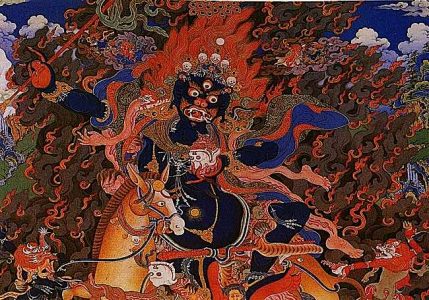
As with all Tantric Deities, every element and color of the image has many layers of meaning. As a higher Tantra practice — Palden Lhamo, typically, should not be practiced until the practitioner already has one Higher Tantric Empowerment — her symbols actually carry three-layers of meaning. From Robert Warren Clark, “Palden Lhamo,” in The Arts of India, South East Asia, and the Himalayas: [9]
“Every detail of Palden Lhamo’s appearance and accoutrements is symbolic on three levels: outer, inner, and secret. The outer level is related in her history as the woman warrior who fought the demon king of Lanka. The inner level consists of symbolic meanings related to the path to liberation. On the secret level, taught only to initiates, every detail becomes significant as an element in the mystical practice of internal Tantric yoga.”
Palden Lhamo has one face and two arms. On the inner level of symbolism, she holds in her mouth the demon of mental afflictions. She bites down on this demon with her sharp fangs of mindfulness, circumspection, heedfulness, and diligence. Her red hair rising upward represents the blazing fire of perfect wisdom (jnana) that incinerates all worldly conceptions (vikalpa), which are the underlying causes of all misery. She wears the five-skull crown showing that she has extinguished the five poisons (greed, anger, ignorance, pride, and jealousy). The third eye of wisdom is wide open in the middle of her forehead. The Tantric symbol of the sun of wisdom marks her navel, and the moon of compassion marks her crown. The peacock-feather parasol of ultimate attainment rises above her head. A long necklace of fifty severed heads is strung on a wire representing intestines. The fifty heads correspond to the fifty worldly states of mind that must be cut off.
Many Names and Tantric Source
 Palden Lhamo goes by many names: Shri Devi, Magzor Gyalmo. Tibetan: pal den lha mo, mag gyi zor le, gyal mo. English: Glorious Goddess, the Queen who Repels Armies, or the Queen who has the power to turn back armies. Sanskrit: Shri Devi, Yakshi Remati. In fact, Shri Devi is more of a “class” of deities, which includes Magzor Gyalmo. According to Himalayan Art:
Palden Lhamo goes by many names: Shri Devi, Magzor Gyalmo. Tibetan: pal den lha mo, mag gyi zor le, gyal mo. English: Glorious Goddess, the Queen who Repels Armies, or the Queen who has the power to turn back armies. Sanskrit: Shri Devi, Yakshi Remati. In fact, Shri Devi is more of a “class” of deities, which includes Magzor Gyalmo. According to Himalayan Art:
“Shri Devi, Yakshi Remati): belonging to the larger class of enlightened protector deities known as Shri Devi. Magzor Gyalmo is regarded as a wrathful emanation of the peaceful goddess Sarasvati, although popular in both Hinduism and Buddhism, the Buddhist deity is more properly known as Vajra Sarasvati and of a different entity and nature than the Hindu goddess Sarasvati. Within the Buddhist Tantric tradition Vajra Sarasavti is believed to be an enlightened deity while the Hindu form of the goddess is believed to be worldly in nature and not enlightened.
Amongst the many forms of Shri Devi, the specific form of Magzor Gyalmo, blue-black and wrathful, is recognized by having one face and two hands, holding aloft with the right hand a vajra tipped staff and in the left a skullcup held to the heart. She rides side-saddle atop a mule. Above her head is a large peacock feather parasol. In the Sakya and related Traditions there is a snake ornament for the right ear and a lion for the left. In the Gelug Tradition this is reversed and the lion is an ornament for the right and the snake for the left. According to the lunar calendar the special day for worship of Magzor Gyalmo is the 14th of the month.
The textual source for Magzor Gyalmo is the Dakinyagnijihajvala Tantra, Dege Kanjur, volume 98, pp.223-253. It is found in the Nyingma Tantra section, vol.3. TBRC w22084.”
Beloved, Terrifying Protector
Thinking of Her cannibal-demon face — with the garland of fifty blood-dripping decapitated heads hanging around Her neck — love is probably the last thing that jumps to mind. Your hands probably shake as you make a tea offering to this ferocious persona. Yet, like the stern parent, with wildly glaring eyes, she’s there to keep you on track, to keep you practicing, to keep you focused on Enlightenment.
Her snarling ghoulish face — in some ways more memorable and easily visualized than the lovely face of Her lighter emanation White Tara — is there to caution you: do your practice, get to work, help all beings, bring compassion to the world. Stop wasting time with video games!
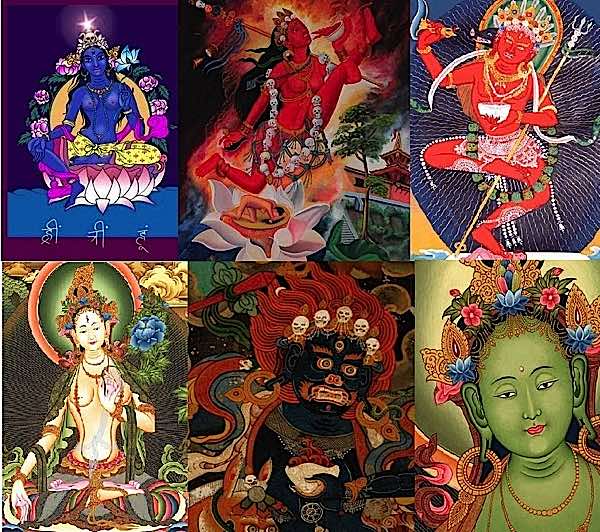
Yet, despite Her terrifying image, Palden Lhamo, or Shri Devi as she’s known in Sanskrit, is a beloved emanation of enlightened Vajra Sarasvati, herself an emanation of Tara and Prajnaparamita. To Tibetan Buddhists, She is a national icon of Tibet, the protector of the Dharma and special protector of the Dalai Lama — and the angry parent who keeps you on track. She’s not an abusive parent; she’d never lay a hand on Her child. But Her voice, visage, and mantra are the protective mother power personified.
A full description of the Glorious Goddess
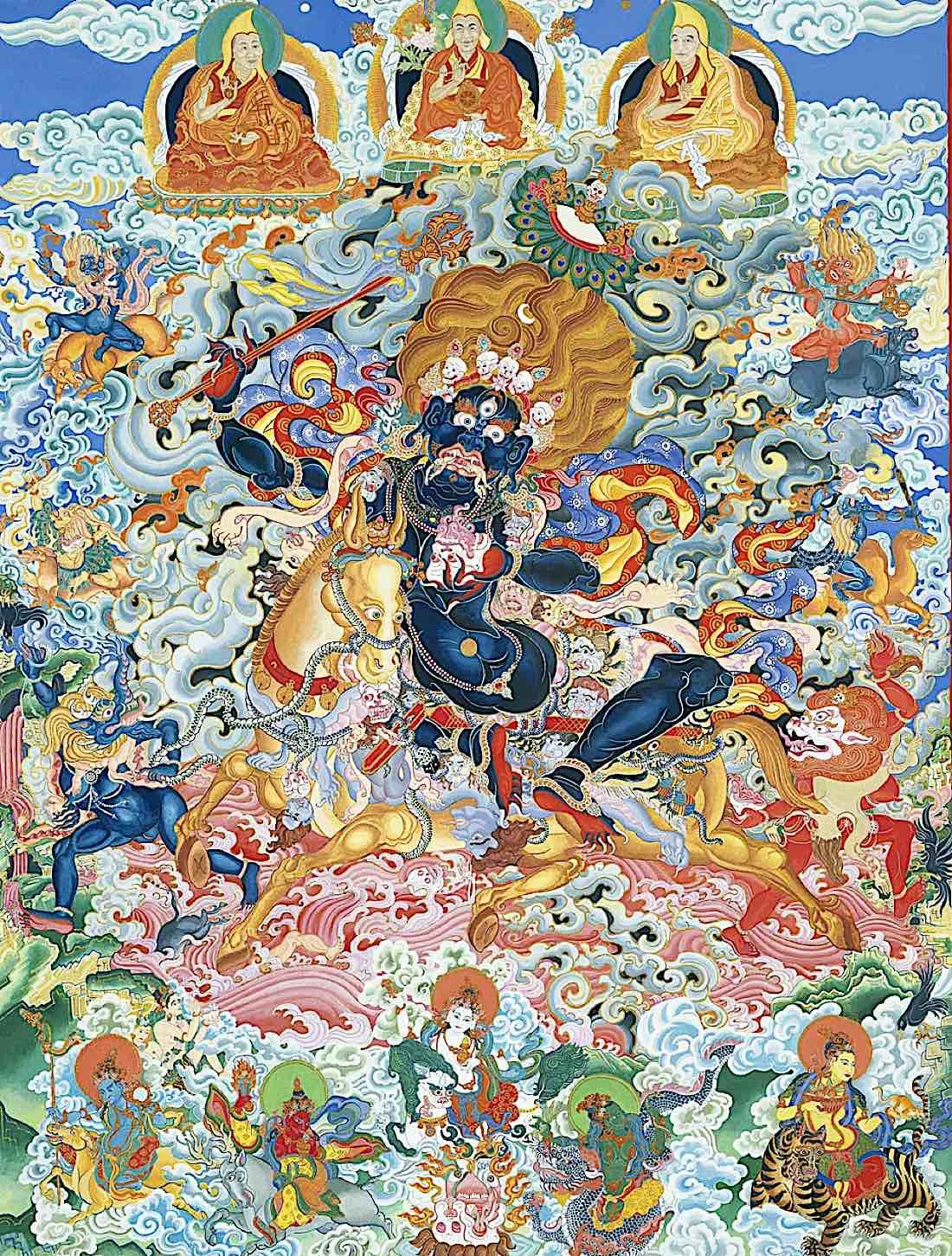
From Robert Beer: “Palden Lhamo (dPal-ldan lha-mo), the ‘Glorious Goddess’, is the main protective goddess of the Tibetan state, and she is depicted here in her form as Magzor Gyalmo – the ‘Queen who repulses armies’. She rides her mule across a swirling ocean of blood and fat, amidst a dark maelstrom of wind and fiery sparks. She is blue-black in colour, with one face and two arms. With her right hand, she wields aloft a vajra-topped red sandalwood club, and with her left hand she holds the upturned skull of a ‘misbegotten child’ in front of her heart, its cranial cavity filled with magical ‘charm blood’. She is adorned with black silks, a flayed human skin, a hair loincloth, and both jewel and bone ornaments. She wears broken chains around her ankles, a crown of five dry white skulls, a long garland of fifty freshly severed heads, a serpent necklace and belt, and her forehead, cheeks, and chin are smeared respectively with human ash, blood, and fat. She has three round red eyes, four sharp canine teeth, and her tawny hair streams upward like fire. A human corpse lies within her mouth, a roaring lion leaps from behind her right ear, and a poisonous snake darts from behind her left ear. She has a protruding stomach, sagging breasts, and thin limbs. The sun blazes from her navel, the crescent moon adorns her crown, and a canopy of peacock feathers floats above her head.
“A gale emanates from the crown of her head, and upon this wind ride the four ‘Queens of the Four Seasons’, each of which rides upon a different animal, holding skull-cups of blood in their left hands and different weapons in their right hands.
 “Palden Lhamo possesses five magical weapons: a tally-stick scored with curses that is tucked into her serpent waistband; a pair of divination dice; a skin sack full of contagious diseases and a bundle of red curses, which hang upon serpents from the front of her saddle, and a ball of variegated thread that hangs from the rear of her saddle. Her saddle is fashioned from a cannibal’s skin, with a demon’s upper skull at the front and its jawbone at the rear. The bridle and reins of the mule are fashioned from poisonous serpents, and the three eyes of her mule gaze over the past, present, and future.
“Palden Lhamo possesses five magical weapons: a tally-stick scored with curses that is tucked into her serpent waistband; a pair of divination dice; a skin sack full of contagious diseases and a bundle of red curses, which hang upon serpents from the front of her saddle, and a ball of variegated thread that hangs from the rear of her saddle. Her saddle is fashioned from a cannibal’s skin, with a demon’s upper skull at the front and its jawbone at the rear. The bridle and reins of the mule are fashioned from poisonous serpents, and the three eyes of her mule gaze over the past, present, and future.
“At the front and rear of the mule are Palden Lhamo’s two attendants: Makaravakra, the blue ‘crocodile-headed’ dakini who leads the mule by its snake reins; and Simhavakra, the red ‘lion-headed’ dakini who guards the mule’s rear. In the lower foreground are skull offerings of the five sense organs (top), blood and nectar (center), and a torma or ‘sacrificial cake’ (bottom). In the bottom corners are the four goddesses who accompany and flank Palden Lhamo in each of the four directions. In the lower-left corner and riding upon a white mule is Zhi-ba’i Lha-mo, the ‘pacifying’ white goddess of the rear flank, who holds a silver mirror and a silver medicinal casket.
“Above her and riding upon a yellow mule is rGyas-pa’i lha-mo, the ‘enriching’ yellow goddess of the right flank, who holds a golden flask of nectar and a golden tray of wish-granting jewels. In the lower right corner and riding upon a black mule is Drag-po’i Lha-mo, the ‘destructive’ black goddess of the front flank, who holds together a mummified corpse and a rope snare, and a tally-stick scored with curses. Above her and upon a red mule is dBang-gi Lha-mo, the ‘subjugating’ red goddess of the left flank, who holds an iron hook and a rope snare. The turbulent landscape depicts swirling oceans of blood, clouds, lightning, hail, and sharp rocky peaks. Countless black spirits, black birds, black dogs, black animals, and black women follow in the retinue of Paldan Lhamo.”
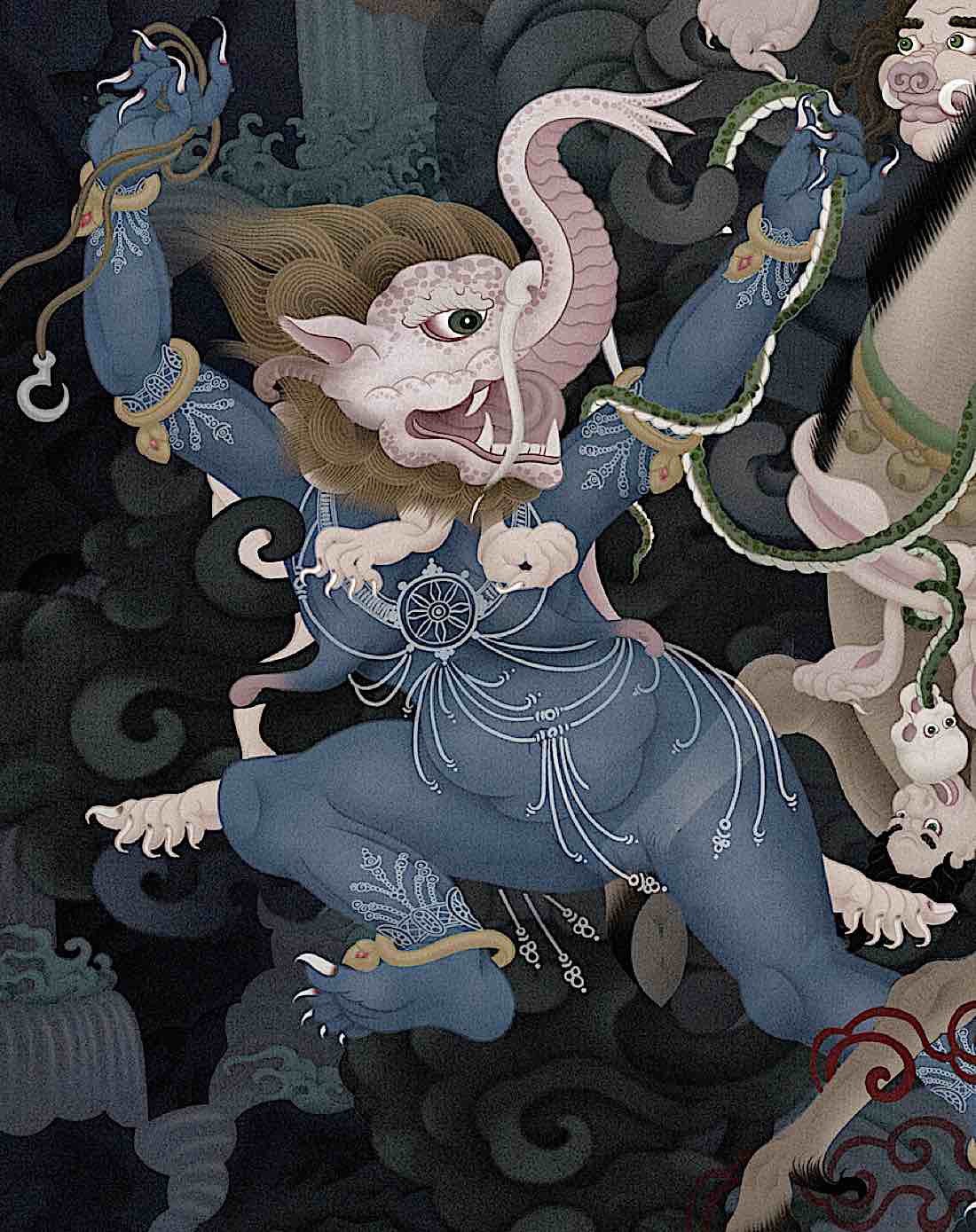
Two attendants: Lion-faced Dakini and Makara-faced Dakini

She is joined by her two acolytes, Makaravaktra (sea monster-headed goddess) and Simhavaktra (lion-headed goddess). Both are important divinities of the dakini class of protective goddesses. Makaravaktra protects followers of the Buddha from dangers arising from the underworld, and Simhavaktra protects from dangers arising in the upper world. They serve Palden Lhamo and help extend her power to both worlds. The inner meaning of this relates to Palden Lhamo’s power to purify and transform both the upper world of the conscious mind and the underworld of the unconscious.
Embracing the Shadow: Wrathful Enlightenment
The Shadow can either be embraced or feared. For healing, psychologists usually describe the “Shadow” of our human psyche as something that should be integrated and embraced — rather than shunned as a cause of suffering. In fact, Psychologist Rob Peerce explains, “deity appears in wrathful form because it embodies potent power …all the destructive demonic characteristics exemplified in the deity are directed at the ultimate destruction of stupidity, selfishness and ego-grasping.” [1]

Why practice or meditate on such a ferocious emanation of Enlightenment? According to Venerable Losang Samtem,
“There are so many Buddhas and Bodhisattvas who are constantly willing to help all living beings overcome suffering… The most important and powerful protector deity in Buddhist history is Panden Lhamo.” [2]
(Alternate spelling of Palden Lhamo.) The Venerable Director of the Tibetan Buddhist Center of Philadelphia adds, “Even though these Enlightened beings, including Panden Lhamo, are always willing to help, it is necessary for us to cultivate the potential within ourselves. We need to be open to receive the blessings of these deities. [Note: Practice suggestions in the last section of this feature.]
Begin Your Day With Tara, End with Palden Lhamo?

Tibetan Buddhists often begin their day with the lovely recitation of the Praise to the 21 Taras, a soothing and uplifting practice of lightness and comfort. Yet, for many lay practitioners, even those who do not have initiation into the practice, the Palden Lhamo tea ceremony is a short, but important, daily practice.
In the West, where ferocious and wrathful emanations of the Buddhas are easily misunderstood, teachers normally recommend full initiation prior to practicing. Certainly, to practice the actual sadhana of Palden Lhamo this is required. Why? In part, because the imagery is easily misunderstood unless a student understands the symbolism’s weighty meaning.
Venerable Losang Samtem explains: “In the Himalayas, people may go to temples, or in their own home… At home, they will offer the drink by themselves.”
It may seem odd to consider both White Tara, and dark Palden Lhamo as Mothers — emanations of the same being. Yet, mothers can be ferocious when they need to be. “She is a ferocious looking crone, a wild and terrible demoness, riding a mule across an ocean of blood…”, describes Rob Preece in The Psychology of Buddhist Tantra. [1] “Thus, as in all deities, a dual nature is evident; light and dark, upper world and underworld, peaceful and wrathful. The forcees of the Shadow are not inherently demonic and terrible. Light and dark, good and evil, creation and destruction are relative dualities that have no ultimate true nature.”
A Tara That Sends You Screaming?
Yet, one look at White Tara’s wrathful emanation, Palden Lhamo, and — never mind integration of the shadow psyche — She is enough to send one screaming for the light, never to return to the shadows. She is so terrible, that some teachers advise even initiated students to do the practice of Yamantaka — among the most wrathful of Buddhas — before attempting Hers. Is it because She is so terrible we need the protection of the great “death foe” Yamantaka? Or, is it because She is so indelibly powerful that we need to be grounded first? Or is it because Yamantaka is Her consort?
Palden Lhamo’s Mantra chanting:
NOTE: With this wrathful protector, even in her Sadhana, usually we do NOT self-generate, but visualize her glorious presence in front of us. To practice Her Sadhana, we generally generate as our Yidam first. (In other words, we visualize ourselves as our Yidam, as given by our teacher, NOT as Palden Lhamo.)
Palden Lhamo’s mantra [6] is (Refer to your teacher for permission. You may or may not require Lung or empowerment, depending on tradition. This mantra is not “secret” today simply because it’s published everywhere, but it is best to refer to your Lama for advice on its use.):
Jo ramo jo ramo jo jo ramo thun jo kala ra chen mo ramo acha dacha thun jo rulu rulu hung jo hung
In Sanskrit (transliterated):
BHYO RAKMO BHYO RAKMO BHYO BHYO RAKMO T-HUN BHYO KHA LA RAK CHEN MO RAKMO ABYATABYA T-HUN BHYO RULU RULU HUM BHYO HUM
More commonly, the Sanskrti mantra is used, but the JHO is pronounced instead of BHYO:
JHO RAKMO JHO RAKMO JHO JHO RAKMO TUN JHO KHA LA RAK CHEN MO RAKMO AVYATAVYA TUN JHO RULU RULU HUM JHO HUM
What is it about the ferocious deities of Enlightenment that is both repellent and fascinating to Westerners? What are we to make of fangs, a necklace of fifty blood-dripping (freshly cut) human heads, and a bag of diseases for destroying enemies? Not to mention, She’s a cannibal-demon, carries the skullcup of an incest-born child and… well, enough said. You’re either repelled and revolted at this point — or — you nodded your head with understanding of the deep, deep symbolism of these wrathful ciphers. For advanced Tantric Buddhist practitioners, there is nothing revolting about wrathful deities. The symbolism is vastly profound, made the more so by the fact that the imagery is so terrifying.
The mantra in script:

The Dark Cipher of Palden Lhamo
 And ciphers they certainly are. Psychologists as early as Carl Jung have long understood the importance of embracing the Shadow.
And ciphers they certainly are. Psychologists as early as Carl Jung have long understood the importance of embracing the Shadow.
The language of the psyche is symbol and cipher, which is certainly why so many psychologists see Tantric Buddhism as very grounded and effective. In Vajrayana Buddhism we visualize symbols with all the senses. We integrate the shadow and the light both.
Unlike some paths, that might shun the dark — or turn the unsavory into Devil and Demon — Tantric Buddhists take a holistic, psychologically sound approach to spiritual practice.
So, we might meditate on the merits of beautiful White Tara, emblematic of compassion, love, vibrant long life and healing — and then with as much enthusiasm visualize Her darker side, Palden Lhamo, the Cannibal Queen, riding on a black tornado, across an ocean of blood.
“The sun shines from her navel and her hair is adorned with a crescent moon – peacock feather jewel… Her steed is bridled and trimmed with vipers… from which hang a bag of diseases…” [7]
What do all the symbols mean? There are too many to cover in a short piece — a teacher might spend a weekend just explaining them all — but here are some of the most noticeable:
- a bag of dice — to determine men’s lives
- Lion decorating her ear: given by Kubera for protection
- a hammer given by Vajrapani (maybe to pound some sense into her children?)
- her saddle made of the flayed skin of her own child — to remind us not to be attached to worldly things
- red flaming hair indicates her wrathful nature and also wisdom
- crown of five skulls symbolizing the transformation of the five passions
- skullcap filled with nectar: blissful emptiness
- In her form as Tsomo Remati, holds a peacock feathered triple-blade dagger, symbolizing the “goddess’s triumph over the three poisons” [8]
Captain Kirk, Anyone? (Skip This Section if You’re Annoyed by Trek Metaphors)
I know, I know, Kirk metaphors are so tiresome, but I’ll throw one in anyway. For those who remember Star Trek, one of the most fascinating episodes involved a “transporter” malfunction that split Captain Kirk into a “Good Kirk” and a “Dark Kirk.” Although, at first, we see the Dark Kirk as revolting, as he foams at the mouth and is layered in sweat, with a leering, evil look on his face, it soon become apparent that “Good Kirk” can’t function without him. He can’t make life-changing decisions. He can’t save the Enterprise. He can’t even decide what food to eat. He’s full of compassion, and sweetness and love — very White Tara.
The Star Trek Scene “I’m Captain Kirk!”
Then there’s the Dark Kirk. He’s nasty, inappropriate, selfish, angry, emotional, driven, nearly psychotic. And, he too, it seems, can’t function without his better half, “Good Kirk.” Only when the two are fused together in the transporter, can they, together, save the ship from destruction. Good Kirk-White Tara, and Dark Kirk-Palden Lhamo, together are powerful and perfect.
Okay, enough Star Trek, I promise. But that episode of the old sixties television show was soundly based on psychology (in my opinion).
Psychology of Shadow
The bottom line, Tibetan Buddhism has long embraced sound psychological aspects to practice. Palden Lhamo helps practitioners to face up to their Shadow psyche, then welcome and absorb the darkness into their entire integrated and whole being.
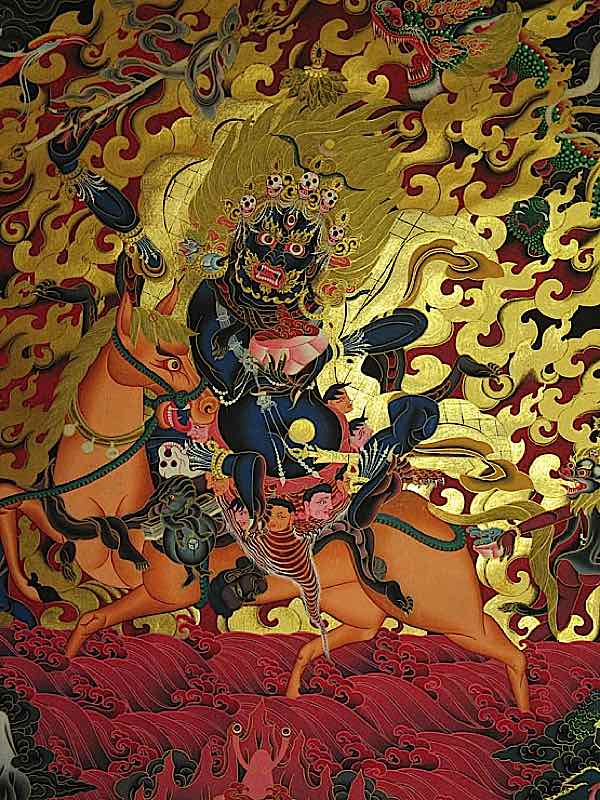
Psychologist Rob Preece explains: “It is important to distinguish between two different dimensions of the Shadow; one that has become sick and demonic because it is repressed, and the other… yet it is still an aspect of Buddha Nature… We fear this side of the Shadow as antithetical to the ego’s need for security and predictability, but it cannot be made light and beautiful; that is not its nature.” Repressed shadow can lead to illness.
In Tantric Buddhism, Preece continues, “All the forces of the Self in the aspect of the wrathful deity are directed against egoistic abuse of power… Only when this egotistical disposition is tamed and transformed can the Shadow be integrated into the spiritual path, rather than remaining a cause of suffering.” [1]
Palden Lhamo’s Many Roles
Not only is she an enlightened Dharma Protector, a ferocious motherly protector, she has also been taken as the chief Dharma Protector of the Dalai Lama and the Ganden monastery. A special scroll painting of Shridevi travels with the Dalai Lama’s wherever they go. Interestingly, for centuries no one looked at this thangka, kept sealed in a special red tube, until, in 1940 “the present Dalai Lama, then aged about seven and on his way to be enthroned, was met close to Lhasa by a great crowd of officials and notables, one of whom had brought the painting, hidden as usual in its case. On seeing it near the entrance to his tent, he promptly grabbed it, took it inside, and opened it. The picture that had not been unveiled for so long was revealed. The Dalai Lama surveyed it and then replaced it in its case. Everyone present was amazed at what he had done.” [3]
Palden Lhamo’s retinue is “so large that the description of it would fill a whole iconographical book.” [3] It includes four Queens of the Seasons, five Goddesses of Long Life, and a retinue of female protectresses known as Mahakali.
Jho!
Mind-essence working the four miraculous activities,
Not deviant from the essence, neither being mind alone,
Absolute indivisible, free of color or form
Her miracles mere magic, fitting each being’s mind;
She manifests, She the ferocious Glory Goddess!
Fierce maker, Fierce Being, her reality is ferocious
Chief Lady of the retinue of the fierce,
Her symbolic body a glistening dark black!
I bow to the all-terrifying Mother Goddess!
Fiercely pray free of diseases, demons, foes and obstructions! [4]
Palden Lhamo Tea Offering and Praise

This praise and prayer, accompanied by a simple tea offering, will honour the Glorious Goddess Palden Lhamo, without actually requiring initiation. The full Sadhana, of course, DOES require initiation. If you do have Empowerment or permission, it is, of course, best to do the full tea ceremony per your tradition.
Tea
Prepare very strong tea, and put out a cup, usually on a deep plate or bowl — more formally, use a Serkyem. In the bowl you add some grains. Fill the cut with tea. Recite the praise, and with the last line in each verse, pour a little more tea so that it overflows (symbolizing abundance.). If that is too difficult, simply pour out the tea, then recite the verses. Make sure to “take refuge in the Three Jewels first” and “Dedicate the Merit” at the end.
Refuge and Bodhichitta
I go for refuge until I am enlightened
To the Buddha, the Dharma, and the Supreme Assembly.
By my merit from giving and other perfections,
May I become a buddha in order to benefit all sentient beings. (3x)
Bless the tea
Recite: OM AH HUM (3X)
Prayer and Requests
O gurus and yidams who send a rain of all that is desired,
Mistress of the desire realm and host of Dharma protectors and guardians,
Please accept this libation having the five desirable qualities
And bestow the activities that will accomplish all desired aims.
JHO Supreme Dharma protector guarding the doctrine of the guide,
Who protects yogis as she would her child and is skilled in magic powers:
To the ruler of the desire realm, the glorious goddess Pälden Lhamo,
I request and make offerings; please perform the entrusted actions. (3x) (Pour tea.)
Though not disturbed from the state of ultimate peace,
You arose in a fierce form to subdue enemies of the doctrine.
To the sole mother, queen of the three existences,
I request and make offerings; please perform the entrusted actions. (3x) (Pour tea.)
Dedication
GE WA DI YI NYUR DU DAG
By this virtue, may I quickly
LA MA SANG GYÄ DRUB GYUR NÄ
Attain the state of a Guru-Buddha
DRO WA CHIG KYANG MA LÜ PA
And lead every living being, without exception,
DE YI SA LA GÖ PAR SHOG
Into that enlightened state.
JANG CHHUB SEM CHHOG RIN PO CHHE
May the precious bodhicitta
MA KYE PA NAM KYE GYUR CHIG
Not yet born arise and grow.
KYE WA NYAM PA ME PA YANG
May that born have no decline
GONG NÄ GONG DU PHEL WAR SHOG
But increase more and more.
NOTES
[1] The Psychology of Buddhist Tantra, Rob Preece The Psychology of Buddhist Tantra,(* affiliate link)
[2] The Panden Lhamo Tea Ceremony from Losang Samtem. Losang Samten is spiritual director of the Tibetan Buddhist Center of Philadelphia, Chenrezig Tibetan Buddhist Center of Middletown, Connecticut, Chenrezig Himalayan Cultural Center of El Paso, Texas, and a frequent visitor and teacher in Lake Tahoe and Chico, CA, as well as in Canada. He travels extensively, sharing his knowledge of Buddhist philosophy and meditation, as well as his skill in Tibetan ritual arts. Download PDF>>
[3] Female Deities of Buddhism, Vesantara (Amazon affiliate link>>)
[4] Essential Tibetan Buddhism, Robert Thurman, HarperCollins, San Francisco 1996 (link to Amazon Buddha Weekly affiliate.)
[5] Serkyem: Golden Libation Offering to the Glorious Goddess Palden Lhamo.
[6] Losang Samten
[7] Khandro Net “Palden Lhamo”
[8] The Handbook of Tibetan Buddhist Symbols, page 128, Serinda Publications
[9] Robert Warren Clark, “Palden Lhamo,” in The Arts of India, South East Asia, and the Himalayas, Anne R. Bromberg (Dallas: Dallas Museum of Art; New Haven: Yale University Press, 2013), 174-175.
12 thoughts on “Palden Lhamo, the Terrifying Female Protector aspect of Tara: “Sole Mother, Lady Victorious Over the Three Worlds””
Leave a Comment
More articles by this author
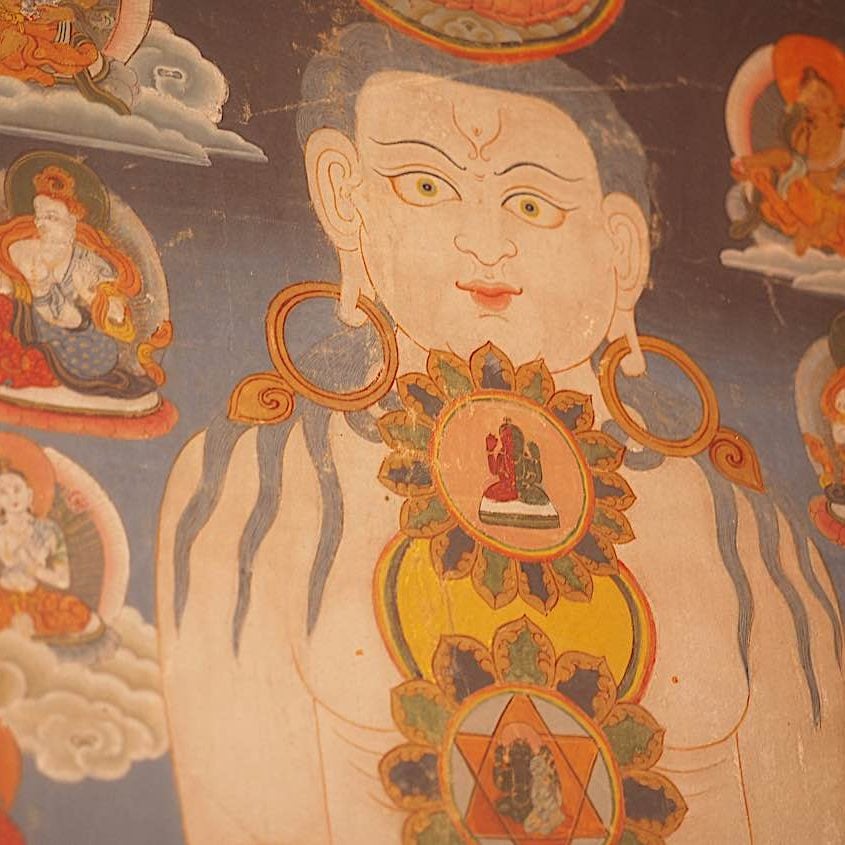
Buddhist body mandala practice in Vajrayana Buddhism — and riding the winds of the inner body “The prana goes where the mind goes.””

4 Guardians of the World and Dharma: the Watchers of the World: the Four Heavenly Kings in Buddhism, Their Mantras and Practice
Search
Latest Features
Please support the "Spread the Dharma" mission as one of our heroic Dharma Supporting Members, or with a one-time donation.
Please Help Support the “Spread the Dharma” Mission!

Be a part of the noble mission as a supporting member or a patron, or a volunteer contributor of content.
The power of Dharma to help sentient beings, in part, lies in ensuring access to Buddha’s precious Dharma — the mission of Buddha Weekly. We can’t do it without you!
A non-profit association since 2007, Buddha Weekly published many feature articles, videos, and, podcasts. Please consider supporting the mission to preserve and “Spread the Dharma." Your support as either a patron or a supporting member helps defray the high costs of producing quality Dharma content. Thank you! Learn more here, or become one of our super karma heroes on Patreon.
Lee Kane
Author | Buddha Weekly
Lee Kane is the editor of Buddha Weekly, since 2007. His main focuses as a writer are mindfulness techniques, meditation, Dharma and Sutra commentaries, Buddhist practices, international perspectives and traditions, Vajrayana, Mahayana, Zen. He also covers various events.
Lee also contributes as a writer to various other online magazines and blogs.






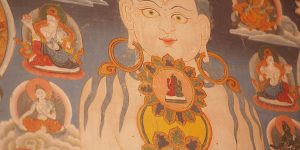


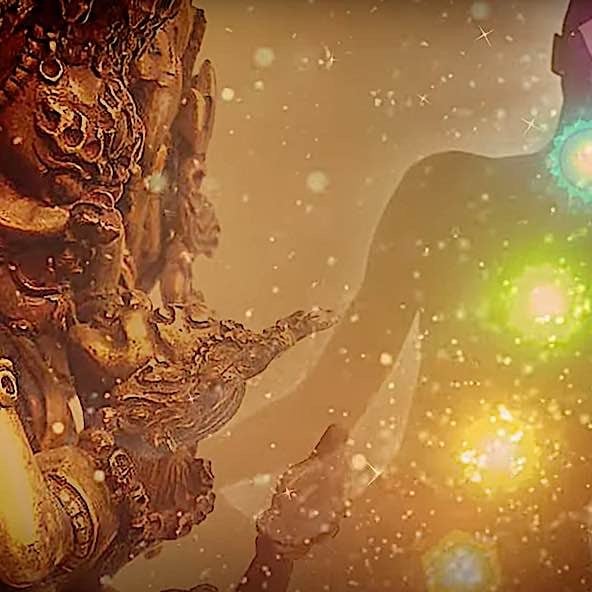







This is very interesting. Thank you for the interpretation. She must have a longer history than Buddhism though. The retinue sounds more like calendar symbolism. The flayed skin of her own child thing sounds to me more like a warning of excessive criticism. I’ve lived in multi generation households and I immediately understood the meaning of that. I came here because i was reading about Tsagaan Sar, the lunar new year among Mongolians. I’m not convinced that they are Buddhist though. Not with the resurgence of Tengri. Really fascinating reading, thank you.
Thanks Danica,
That’s a really insightful and interesting interpretation. Regarding Mongolians and Buddhism, (I think, not being an expert in Mongolia by any means!) there’s always going to be a mix of beliefs. In Japan, many people embrace both Shinto and Buddhism. In Tibet, Bon is equally embraced and treasured. In China, it’s very common to find temples with both Buddhist and Daoist deities (or even here where I am in Canada, the Tai Chi centre near me is described as both Buddhist and Daoist temple.) I don’t know much about Mongolia per se, but there are many Buddhist teachers travelling there yearly to give teachings. I think there’s an overall resurgence in spirituality and the culture of ancestors. Metta, Lee.
thank you for that comment Danica. Could you please elaborate and explain a bit more about how your experience relates to the meaning of the flayed skin? Absolutely fascinated by that comment but also I don’t quite get it. Thank you
Do you have any sources that talk in detail about Palden Lhamo’s retinue, for I’ve been researching a lot of Buddhist deities/figures?
Hi Myles Jude, thank you for asking. Are you asking from a scholarly perspective (i.e. versus practice, which requires empowerment and teachings from a Guru)? From a scholarly perspective, especially vis a vis the entourage, I always make Himalayan Art my first stop. Not only do they have the most beautiful old images/thangkas, they have very detailed and referenced descriptions of symbolism, scholarly references, and also teacher commentaries. If you head over to the main page which serves as a home page for Palden Lhamo, you then can click on any of the images linked there, and each one may have more and more information. Bear in mind the symbolism according to Sakya lineage may be different form Kagyu and Gelug, so you really have to go through the images. They should cite which lineage. Here’s the link: https://www.himalayanart.org/search/set.cfm?setID=164 From there you’ll see links to Subjects, Objects & Types:
– Shri Devi Description (below)
– Shri Devi Forms & Types
– Shri Devi Introduction
– Shri Devi Resource Page
– Shri Devi Outline Page
– Shri Devi Forms Outline
– Shri Devi Traditions & Forms Outline
– Forms Comparison
– Rinjung Lhantab Forms (Jonang)
– Nyingma Tradition Examples
– Bon Tradition: Sipai Gyalmo
– Shri Devi Masterworks
– Confusions
– Others…
If your question is in reference to practice, it’s better to go directly to your teacher, especially for a practice such as Shri Deva Palden Lhamo. Hope that helps. In kindness, Lee
Thanks for answering my question, but I’d like to ask another. Do you know of any sites that feature the likes of the Dhyani Buddhas?
(Also do you know about this site called Yogini Project- I find it a very interesting one).
If you mean besides Buddha Weekly (have you used the search tool, you’ll find many topics covered and each of them have citations and links to the sources you may be interested in), there are many, many sites covering the 5 Buddhas. The same reference I gave you before (Himilayan Art) is a good place to start (search Dhyani Buddhas). Also on our site:
https://buddhaweekly.com/what-does-quantum-physics-have-to-do-with-the-five-buddhas-vairochana-amitabha-akshobya-ratnasambhava-and-amoghisiddhi/
AND
https://buddhaweekly.com/a-map-of-the-mind-universe-the-mandala-of-the-five-buddhas-a-perfect-practice-a-perfect-remedy-for-the-five-poisons/
Hope that helps. Yes, I have visited/ followed Yogini Project. It’s a good project and site.
In the tea ceremony text near the end of the article, the dedication verse is missing the first line of its Tibetan transliteration, which should read “GEWA DI YI MYUR DU DAK” (དགེ་བ་འདི་ཡིས་མྱྱུར་དུ་བདག)
Dear Tara K, Thank you for the correction. The Tibetan line somehow was dropped. We’ve corrected, many thanks. In kindness, Lee
Thank you. It’s really well scholarly have explained. I’m from Mongolia and Palden Lhamo is one of the main practices in Mongolia.
Thank you for the kind words!
i got dream of her oracle dancing what foes that means?